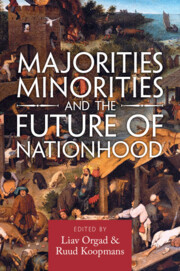46 results
Copyright page
-
- Book:
- Majorities, Minorities, and the Future of Nationhood
- Published online:
- 12 November 2022
- Print publication:
- 24 November 2022, pp iv-iv
-
- Chapter
- Export citation
Figures
-
- Book:
- Majorities, Minorities, and the Future of Nationhood
- Published online:
- 12 November 2022
- Print publication:
- 24 November 2022, pp vii-vii
-
- Chapter
- Export citation
Contents
-
- Book:
- Majorities, Minorities, and the Future of Nationhood
- Published online:
- 12 November 2022
- Print publication:
- 24 November 2022, pp v-vi
-
- Chapter
- Export citation
Tables
-
- Book:
- Majorities, Minorities, and the Future of Nationhood
- Published online:
- 12 November 2022
- Print publication:
- 24 November 2022, pp viii-viii
-
- Chapter
- Export citation
Preface
-
- Book:
- Majorities, Minorities, and the Future of Nationhood
- Published online:
- 12 November 2022
- Print publication:
- 24 November 2022, pp xi-xiii
-
- Chapter
- Export citation
Index
-
- Book:
- Majorities, Minorities, and the Future of Nationhood
- Published online:
- 12 November 2022
- Print publication:
- 24 November 2022, pp 307-320
-
- Chapter
- Export citation
Acknowledgments
-
- Book:
- Majorities, Minorities, and the Future of Nationhood
- Published online:
- 12 November 2022
- Print publication:
- 24 November 2022, pp xiv-xiv
-
- Chapter
- Export citation
A Note on the Cover
-
- Book:
- Majorities, Minorities, and the Future of Nationhood
- Published online:
- 12 November 2022
- Print publication:
- 24 November 2022, pp xv-xvi
-
- Chapter
- Export citation
1 - Majority–Minority Constellations
-
-
- Book:
- Majorities, Minorities, and the Future of Nationhood
- Published online:
- 12 November 2022
- Print publication:
- 24 November 2022, pp 1-34
-
- Chapter
- Export citation
Contributors
-
- Book:
- Majorities, Minorities, and the Future of Nationhood
- Published online:
- 12 November 2022
- Print publication:
- 24 November 2022, pp ix-x
-
- Chapter
- Export citation

Majorities, Minorities, and the Future of Nationhood
-
- Published online:
- 12 November 2022
- Print publication:
- 24 November 2022
Copyright page
-
- Book:
- The Struggle Over Borders
- Published online:
- 28 June 2019
- Print publication:
- 04 July 2019, pp iv-iv
-
- Chapter
- Export citation
References
-
- Book:
- The Struggle Over Borders
- Published online:
- 28 June 2019
- Print publication:
- 04 July 2019, pp 249-264
-
- Chapter
- Export citation
Contents
-
- Book:
- The Struggle Over Borders
- Published online:
- 28 June 2019
- Print publication:
- 04 July 2019, pp v-vi
-
- Chapter
- Export citation
Figures
-
- Book:
- The Struggle Over Borders
- Published online:
- 28 June 2019
- Print publication:
- 04 July 2019, pp vii-viii
-
- Chapter
- Export citation
Index
-
- Book:
- The Struggle Over Borders
- Published online:
- 28 June 2019
- Print publication:
- 04 July 2019, pp 265-276
-
- Chapter
- Export citation
Contributors
-
- Book:
- The Struggle Over Borders
- Published online:
- 28 June 2019
- Print publication:
- 04 July 2019, pp xi-xi
-
- Chapter
- Export citation
Appendices
-
- Book:
- The Struggle Over Borders
- Published online:
- 28 June 2019
- Print publication:
- 04 July 2019, pp 238-248
-
- Chapter
- Export citation
Part I - Domestic Impacts
-
- Book:
- The Struggle Over Borders
- Published online:
- 28 June 2019
- Print publication:
- 04 July 2019, pp 35-116
-
- Chapter
- Export citation
Part III - Conclusion
-
- Book:
- The Struggle Over Borders
- Published online:
- 28 June 2019
- Print publication:
- 04 July 2019, pp 205-237
-
- Chapter
- Export citation



